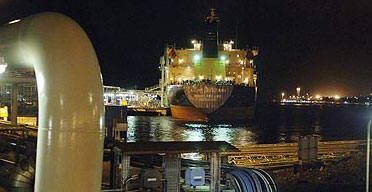MONGSTAD, June 22 – Norway’s most polluting industrial site, the Mongstad oil refinery, is now looking to lead the way on fighting climate change.
Located on the country’s west coast, the refinery spits out around 1.7 million tonnes of carbon dioxide every year – a gas that is widely blamed for global warming.
But the Mongstad site will soon start road-testing new technology known as ‘Carbon Capture and Storage’ (CCS) as its owners look to reduce the amount of carbon dioxide emitted in its day-to-day operations.
"CO2 is a real threat but we believe it can be addressed with technology and different consumption patterns," said Jon Arnt Jacobsen, StatoilHydro executive vice president for manufacturing and marketing.
The refinery will first host a small-scale project pilot capable of capturing 100,000 tonnes annually from 2011. A few years later a full-scale facility which will remove most of the CO2 emitted by the refinery and the gas power plant being built here.
CCS technology is already deployed on a number of smaller factories. It uses solvents to separate out the carbon dioxide produced from industrial fumes. It can then be transported by ship or pipeline and buried underground.
This method will contribute 20 percent of the greenhouse gas emissions cuts needed by 2050 to keep global warming at an acceptable level, according to the International Energy Agency.
"If you are going to burn coal as indeed we have committed to doing in thousands of power plants around the world, we don’t have any option apart from being able to capture carbon dioxide," Rajendra Pachauri, the head of the UN climate panel (IPCC) that won the Nobel Peace Prize in 2007, told AFP.
The G8 group of nations, the world’s eight leading industrialised economies, have thrown their weight behind the idea of launching 20 large scale CCS projects by 2010.
StatoilHydro says the Mongstad project is leading the way in this field and it could help cut as much as four percent of the Scandinavian country’s greenhouse gas levels.
But the only illustration so far of this ambitious project is a flat, empty space where a carbon capturing unit is meant to stand.
— ‘We don’t even know if it works’ —
That is one of the reasons why some environmentalists are sceptical about the CCS’s potential to help combat climate change.
"CO2 emissions have to come down before 2015, which means CCS will arrive too late," said Truls Gulowsen, the leader of Greenpeace’s Norwegian branch.
"We don’t even know if it works but we carry on building coal power plants by the dozen in the hope that perhaps one day we will be able to capture their CO2," he added.
Greenpeace says the current focus on CCS –a technology which on top of that requires a lot of energy– is diverting time and money from other more concrete measures to fight climate change.
The group says big industry should concentrate more on energy efficiency and developing renewable energy sources.
But that view is rejected by Frederic Hauge, who heads up the Norwegian environmental group Bellona.
"We do not see any chance (of cutting emissions) at all without CCS," he said.
Hauge points out that the amount of energy required to build solar panels, construct wind turbines and produce biomass will also create a lot of greenhouse gases.
"If you’re going to produce all the renewables we need for the developing world, CO2 emissions will soar without CCS," he said.
Yet question marks remain over the cost of such technology as CCS is a long way from being commercially viable.
StatoilHydro says it will cost between 1,300 and 1,800 kroner (145-200 euros, 200-280 dollars) for each tonne of CO2 captured — and that estimate does not include transportation and storage costs.
In Mongstad, the Norwegian government has agreed to pick up the tab which will amount to some 25 billion kroner for building a full scale CCS facility.
But in other places, big industry or energy firms might find it more tempting to buy carbon credits, which currently sell for just around 15 euros per tonne of CO2 emitted.
Most experts agree that while carbon remains so cheap, many companies will not find the technology attractive.
"The price of carbon is not high enough but should we just sit back and wait until the price is right? This could take years," said Hauge.



































